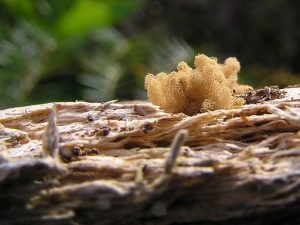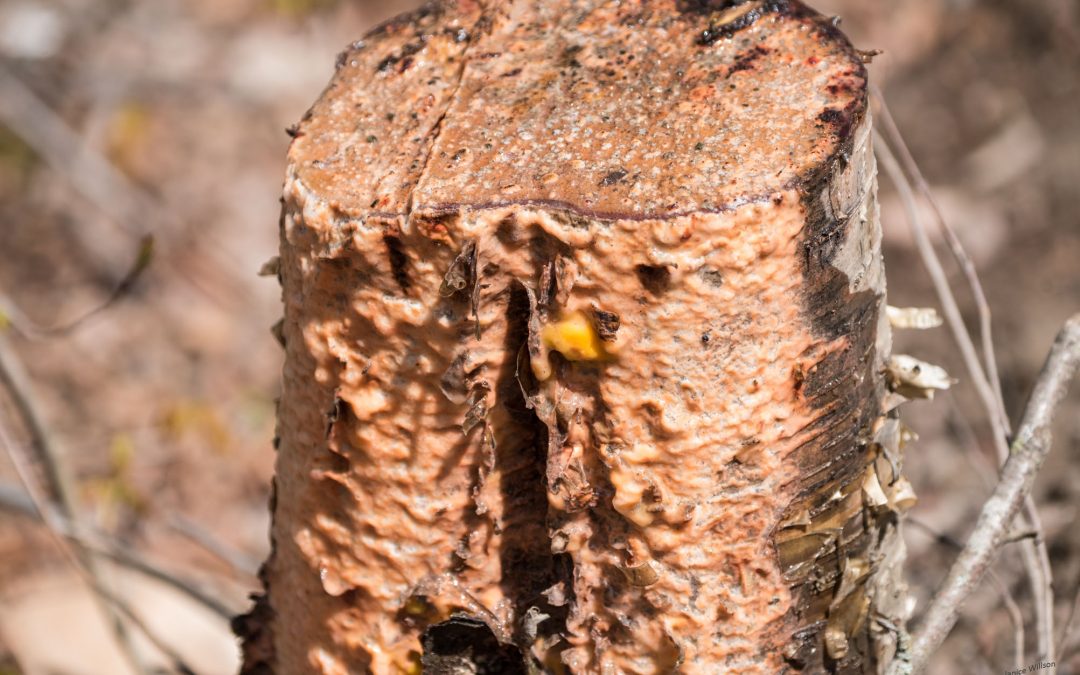On a recent trip to the great outdoors, my husband and I came across some very interesting ‘creatures’. I quite enjoy looking for the smaller biological life forces that are in nature such as mosses, fungi, and lichens. Often these tiny members of this world are the most interesting. We, as humans, are pretty boring biologically speaking when you compare us to something like lichen or in the case of this blog, a slime mold. Slime mold…that doesn’t sound too appealing I know, but bear with me. You will come to admire Slimey.
If you have ever watched the movie ‘The Blob’, the whole look and action of a slime mold may frighten the daylights out of you but it is truly a fascinating creature (even Steve McQueen would find it so as he was fighting their spread). Now, some may think using the term creature would be inaccurate but it has a definition that crosses some borders in the animal and plant kingdoms. Slime mold is defined as: “any of about 500 species of primitive organisms containing true nuclei and resembling both protozoan protists and fungi.”-Encyclopedia Britannica. Funny side note here-is every article that I have read regarding the slime mold multiplies their numbers by 200. There are Myxomycetes (true slime molds), Protestelia (minute, simple slime molds), Acrasia (cellular slime mold), Plasmodiophorina (parasitic slime mold), and Labyrinthulina (net slime molds). Just how many times can I actually type slime mold? Maybe it could become a drinking game.
The ambiguity of this organism is apparent in its classification. Slime mold has gone through some name changes over the years. At one time, it was considered an animal because of its ability to creep and it was referred to Mycetozoa from the Greek words for fungi and animal. This classification lasted until the 1970’s. Some earlier researchers referred classified them as Protozoa. Now, the good folks who study fungi (AKA mycologists) consider these unique organisms part of the class Myxomycetes; myxo for slime and mycetes for fungi, although the connection between these guys and fungi remains somewhat obscure and obviously, a lot more study is necessary to completely understand this enigma of the animal/plant world.
The lovely slime mold be gins its life as an amoeba-like single cell. In this phase of its life cycle many of these individuals will aggregate and move together forming a multicellular mass called a pseudoplasmodium that resembles a slug. It will crawl around the ground feeding on decaying organic material, fungi, bacteria, protozoa, and other micro-organisms. When it finds a suitable location with all the right ingredients for reproduction such as warmth, light, and a great view of the forest (maybe not the last one) like the top of a fallen log, the slime mold will form spores and germinate into smaller amoebae and restart the whole process.
gins its life as an amoeba-like single cell. In this phase of its life cycle many of these individuals will aggregate and move together forming a multicellular mass called a pseudoplasmodium that resembles a slug. It will crawl around the ground feeding on decaying organic material, fungi, bacteria, protozoa, and other micro-organisms. When it finds a suitable location with all the right ingredients for reproduction such as warmth, light, and a great view of the forest (maybe not the last one) like the top of a fallen log, the slime mold will form spores and germinate into smaller amoebae and restart the whole process.
The collective of slime mold has very unusual properties and show a rudimentary intelligence. When a part of a slime mold mass becomes physically separated, the cells can find their way back to each other. Studies on a specific slime mold called Physarum have even shown the ability to predict periodic unfavourable conditions in experiments conducted in the laboratory. Researchers from the Bio-Mimetic Control Research Centre in Nagoya, Japan showed that slime mold could negotiate a maze to find the quickest possible route out of four possibilities to a food source. Slime molds are redefining the meaning of intelligence. As it makes its way through its environment, the slime mold will leave a sticky residue to leave a marker as to where it has been before so it does not waste time “looking”(it has no eyes so this is a metaphorical looking) in the same spot for food.
In comparison to the vast majority of organisms on this planet, slime mold has been around a lot longer; they began evolving approximately 600 million years ago and possibly as long as 1 billion (yes, that is with a B) years ago. If you have been around that long, you may have picked up a trick or two that the “more evolved” species do not know about. The organisms have not evolved brain or even a basic nervous system but still are very successful at life. Maybe that should tell us something.
If you would like to grow your own Myxomycetes and teach it to crawl a maze or fetch your slippers, this link provides a step-by-step guide to grow it: http://npsnj.org/articles/myxomycetes.html
Watch the incredible slime mold in transit https://www.bing.com/videos/search?q=orange+slime+mold&view=detail&mid=96FACBC247FCD574E45E96FACBC247FCD574E45E&FORM=VIRE
–Janice Willson
References:
http://www.abc.net.au/science/articles/2000/09/28/189608.htm?site=galileo&topic=latest
https://en.wikipedia.org/wiki/Slime_mold
https://www.scientificamerican.com/article/brainless-slime-molds/
Photo Source: Featured image courtesy of the author Body image of Arcyris nutans, Wellington, NZ courtesy of Tony Wills

